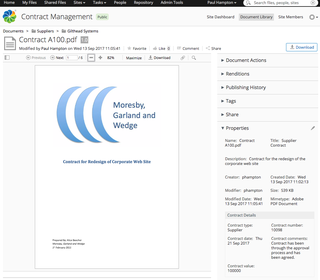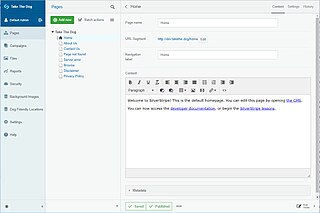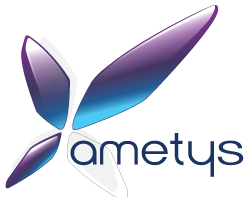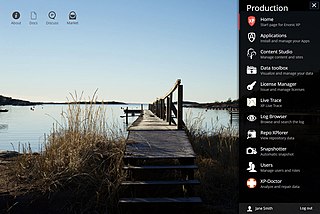
OSGi is an open specification and open source project under the Eclipse Foundation.

OpenCms is an open-source content management system written in Java. It is distributed by Alkacon Software under the LGPL license. OpenCms requires a JSP Servlet container such as Apache Tomcat.

DNN Platform is a web content management system and web application framework based on the .NET Framework. It is open source and part of the .Net Foundation.

Alfresco Software is a collection of information management software products for Microsoft Windows and Unix-like operating systems developed by Alfresco Software Inc. using Java technology. The software, branded as a Digital Business Platform is principally a proprietary & a commercially licensed open source platform, supports open standards, and provides enterprise scale. There are also open source Community Editions available licensed under LGPLv3.
Content Repository API for Java (JCR) is a specification for a Java platform application programming interface (API) to access content repositories in a uniform manner. The content repositories are used in content management systems to keep the content data and also the metadata used in content management systems (CMS) such as versioning metadata. The specification was developed under the Java Community Process as JSR-170, and as JSR-283. The main Java package is javax.jcr.
Apache Jackrabbit is an open source content repository for the Java platform. The Jackrabbit project was started on August 28, 2004, when Day Software licensed an initial implementation of the Java Content Repository API (JCR). Jackrabbit was also used as the reference implementation of JSR-170, specified within the Java Community Process. The project graduated from the Apache Incubator on March 15, 2006, and is now a Top Level Project of the Apache Software Foundation.
An enterprise portal, also known as an enterprise information portal (EIP), is a framework for integrating information, people and processes across organizational boundaries in a manner similar to the more general web portals. Enterprise portals provide a secure unified access point, often in the form of a web-based user interface, and are designed to aggregate and personalize information through application-specific portlets.

Silverstripe CMS is a free and open source content management system (CMS) and framework for creating and maintaining websites and web applications. It provides an out of the box web-based administration panel that enables users to make modifications to parts of the website, which includes a WYSIWYG website editor. The core of the software is Silverstripe Framework, a PHP Web application framework.
The Sun Java System Portal Server is a component of the Sun Java Platform, Enterprise Edition, a software system that supports a wide range of enterprise computing needs.
Nuxeo is a software company making an open source content management system.
Content Management Interoperability Services (CMIS) is an open standard that allows different content management systems to inter-operate over the Internet. Specifically, CMIS defines an abstraction layer for controlling diverse document management systems and repositories using web protocols.

TYPO3 is a Web content management system (CMS) written in the programming language PHP. It can run on a variety of web servers, such as Apache, Nginx, or Internet Information Services (IIS), and on many operating systems, including Linux, Microsoft Windows, FreeBSD, macOS, and OS/2. It is free and open-source software released under the GNU General Public License version 2.

CMS Made Simple (CMSMS) is a free, open source (GPL) content management system (CMS) to provide developers, programmers and site owners a web-based development and administration area. In 2017 it won the CMS Critic annual award for Best Open Source Content Management.
LabKey Server is a software suite available for scientists to integrate, analyze, and share biomedical research data. The platform provides a secure data repository that allows web-based querying, reporting, and collaborating across a range of data sources. Specific scientific applications and workflows can be added on top of the basic platform and leverage a data processing pipeline.
Elcom Technology Pty Ltd is a privately held software company based in Sydney, Australia. It provides web content management, website, portal and intranet software. Elcom's primary product is elcomCMS which is built using Microsoft ASP.NET and Microsoft SQL Server. Version 11.5 of the CMS was released on February 15, 2021.
The JBoss Enterprise Application Platform is a subscription-based/open-source Java EE-based application server runtime platform used for building, deploying, and hosting highly-transactional Java applications and services developed and maintained by Red Hat. The JBoss Enterprise Application Platform is part of Red Hat's Enterprise Middleware portfolio of software. Because it is Java-based, the JBoss application server operates across platforms; it is usable on any operating system that supports Java. JBoss Enterprise Application Platform was originally called JBoss and was developed by the eponymous company JBoss, acquired by Red Hat in 2006.

Ametys is a free and open source content management system (CMS) written in Java. It is based on JSR-170 for content storage, Open Social for gadget rendering and a XML oriented framework. It is primarily designed to run large corporate websites, blogs, intranets and extranets on the same server.

ContentBox Modular CMS is an open-source content management system for CFML, created by Ortus Solutions, Corp. ContentBox has been designed as a modular HMVC software based on Hibernate ORM and the ColdBox Platform.

Enonic XP is a free and open-source web application platform and content management system (CMS) in one based on Java and Elasticsearch. Developed by the Norwegian software company Enonic, the microservice web platform can be used to build progressive web applications, Next.js websites, or web-based APIs. Enonic XP uses an application framework for coding server logic with JavaScript, and has no need for SQL as it ships with an integrated content repository. The CMS is fully decoupled, meaning developers can create traditional websites and landing pages, or use XP in headless mode, that is without the presentation layer, for loading editorial content onto any device or client. Enonic is used by major organizations in Norway, including the national postal service Norway Post, the insurance company Gjensidige, the national lottery Norsk Tipping, the Norwegian Labour and Welfare Administration, and all the top football clubs in the national football league for men, Eliteserien.









